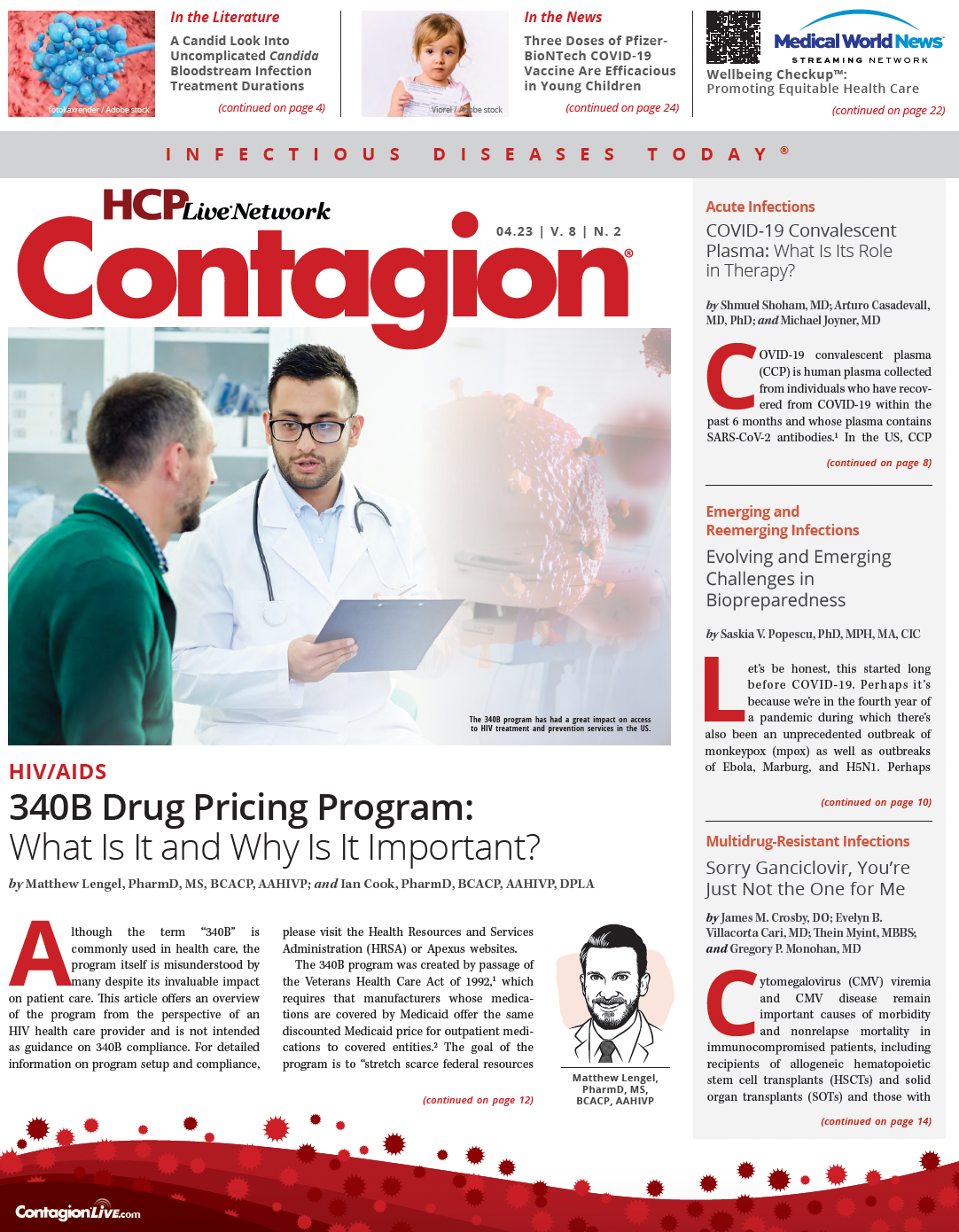Bivalent COVID-19 Boosters: Optimizing Vaccine Development and Infection Protection
Panel moderator Rodney Rohde, PhD, notes that word choice is important and clinicians should emphasize the COVID-19 vaccine is not a live virus but is instead designed to challenge the immune system to protect against the virus.

You can watch this Peer Exchange here.
The bivalent COVID-19 vaccine booster was developed to target the Omicron as well as the original variant of SARS-CoV-2. Although the vaccines’ mRNA technology has improved our ability to rapidly modify them to target multiple strains, education on the safety of these boosters is needed to minimize hesitancy and maximize uptake, according to panelists who participated in a recent Contagion® Peer Exchange moderated by Rodney Rohde, PhD.
BOOSTER PROTECTION RATES
A study that included data on the Moderna and Pfizer bivalent and monovalent COVID-19 boosters found that effectiveness at preventing severe infection resulting in hospitalization or death was 61.8% (95% CI, 48.2%-71.8%) with the bivalent booster that had been administered between September 1 and December 8, 2022, and 24.9% (95% CI, 1.4 to 42.8) with the monovalent booster administered between May 25 and August 31, 2022.1 The analysis also found that effectiveness peaked 4 weeks after administration and waned thereafter.1
These numbers are lower than those for the original COVID-19 vaccine series, which showed efficacy at all-grade infection prevention of 94.1% (95% CI, 89.3%-96.8%) and 95% (95% CI, 90.3%-97.6%) for Moderna and Pfizer, respectively.2,3
However, the initial trials had been conducted when no meaningful mutations had developed in the virus, said Jacinda Abdul-Mutakabbir, PharmD. “The virus is always going to be ahead of us…and we have to consider that,” she noted. “As we go further out from when those individuals received those booster vaccines, we end up in this place where we are constantly losing…in terms of keeping folks out of the hospital. So that means that we have to think about how we provide that maximum protection.”
Although the SARS-CoV-2 virus is likely to persist indefinitely, figuring out ways to keep up with the newest strains and maximizing vaccine uptake is important to minimize the rate at which the virus mutates, Wendy Wright, DNP, said. “The important takeaway…[is that] the longer it stays in our nose and airways, the more likely it is to mutate,” she explained. “We can argue about the flu shots, their efficacy is not fabulous. When we see 60% [effectiveness], we jump for joy. As I tell my patients, 100% of zero is zero. If you don’t get [the vaccine], you don’t have any chance of protection.”
The development of updated boosters should also speed up as the process becomes more streamlined, observed Madeline King, PharmD, and Wright added that the mRNA technology used in the Pfizer and Moderna vaccines could be the basis of future vaccines. “I don’t think the public realizes that it took Moderna one hour to design their vaccine,” Wright pointed out. “I don’t know how long it took Pfizer, but that technology is unbelievably exciting. To be able to change [the vaccine] on a dime is really exciting.”
Breaking down the “red tape” to enable rapid and safe vaccine rollout, pivot quickly to adapt to currently predominant strains, and mass-produce the product are some of the positive outcomes of the pandemic, Rohde said, noting that key steps moving forward include improving vaccine equity across the United States and the world and increasing manufacturing and supply-chain capacity.
EMERGENCE OF VARIANTS AND BOOSTER FORMULATIONS
The currently available bivalent COVID-19 booster shots, which target the ancestral and Omicron BA.4/BA.5 strains of SARS-CoV-2, were approved based on findings from in vitro data on this combination of strains as well as human studies of bivalent vaccine targeting the ancestral and BA.1 strains.4,5
This approach may set a precedent for future variant vaccines and reduce the time between development and public availability, King said. However, according to Wright, lack of in vivo data on the specific strains combinations has made some patients more hesitant. “Patients are savvy and they’ll say, ‘they studied 600 in vitro neutralizing antibodies, they didn’t test it in 30,000 people like they did with the original, so how do I know that it’s safe for me?’ she said. “As great as it is that we have this technology that can pivot on a dime, people are nervous about…technology that can pivot on a dime, and they’re scared to put it into their arms.”
Explaining how approval studies on the bivalent COVID-19 booster were conducted may help doctors educate patients about subvariants and mutations in the spike protein, said Abdul-Mutakabbir. Boosters containing ancestral and Omicron BA.1 strains were found to safely produce neutralizing antibodies against ancestral and Omicron variants in human studies.4,5
As Abdul-Mutakabbir tells patients, although the study did not specifically test the BA.4/BA.5 strain in the currently available bivalent booster, the mRNA of the BA.4/BA.5 spike protein in it is nearly identical to that of the BA.1 spike protein.4,5 “It allows for us to really exercise our scientist brain to think about these 2 [strains],” she said. “They look quite similar, so can we say that we’ll likely see the same things that we saw with the BA.1/original COVID-19 strain study? We don’t have a ton of information, but we have enough to assuage those fears” and be “a little less rigid” during the approval process.
TOO MUCH INFORMATION? WHEN TO SAY LESS
The need to effectively communicate the nuances of mRNA technology in COVID-19 vaccines has been and remains an important lesson of the pandemic, Rohde said. Wright tells her patients that, much like the quadrivalent influenza vaccine, the 9-valent human papillomavirus (HPV) vaccine, and the quadrivalent meningococcal conjugate vaccine, the bivalent COVID-19 vaccine contains different strains of the virus, with the goal of increasing the spectrum of protection.
Unfortunately, a detailed discussion with patients about the science could reduce the likelihood of their receiving the vaccine, whereas message clarity, conciseness, and consistency is more likely to promote vaccine uptake. “I’m short, I’m to the point, and I give a strong recommendation,” Wright said. “The more we go down that rabbit hole… [the more] people feel like we’re trying to convince them [rather than] making a recommendation.”
King agreed that the “deep dive” into the science behind the vaccine might increase patient hesitancy. “Some of the more intricate, detailed, science terminology we use with them might be scary,” she said. “I also think people…forget that there are multiple strains of influenza in the influenza vaccine [and] HPV in the HPV vaccine. People don’t think about that because we just tell them, ‘this is the pneumonia vaccine, this is the HPV vaccine,’ and we don’t go into all of the differences. It’s good to remind them that you give a lot of vaccines with multiple [strains] in them, and the [COVID-19] vaccine is just one you’re hearing a lot about on the news.”
Rohde added that word choice is important and that clinicians should emphasize that the vaccine is not a live virus but is instead designed to challenge the immune system to protect against the virus. “We are the experts, so if you are strong, positive, using that language with patients, that goes a long way,” he said. “Many people are looking to us for that. It’s just like if you’re having surgery—you don’t want a surgeon to be like, what do you want to do? I want my surgeon to say, I’ve got this. I’ve done 100 of these, I’m the expert, we’re going to knock this out, and everything is going to be OK.”
References
1. Lin DY, Xu Y, Gu Y, et al. Effectiveness of bivalent boosters against severe Omicron infection. N Engl J Med. 2023;388:764-766. doi:10.1056/NEJMc2215471
2. Baden LR, El Sahly HM, Essink B, et al; COVE Study Group. Efficacy and safety of the mRNA-1273 SARS-CoV-2 vaccine. N Engl J Med. 2021;384(5):403-416. doi: 10.1056/NEJMoa2035389
3. Polack FP, Thomas SJ, Kitchin N, et al; C4591001 Clinical Trial Group. Safety and efficacy of the BNT162b2 mRNA Covid-19 vaccine. N Engl J Med. 2020;383(27):2603-2615. doi:10.1056/NEJMoa2034577
4. Chalkias S, Harper C, Vrbicky K, et al. A bivalent Omicron-containing booster vaccine against Covid-19. N Engl J Med. 2022;387(14):1279-1291. doi:10.1056/NEJMoa2208343
5. Winokur P, Gayed J, Fitz-Patrick D, et al; C4591031 Clinical Trial Group. Bivalent Omicron BA.1-adapted BNT162b2 booster in adults older than 55 years. N Engl J Med. 2023;388(3):214-227. doi:10.1056/NEJMoa2213082

